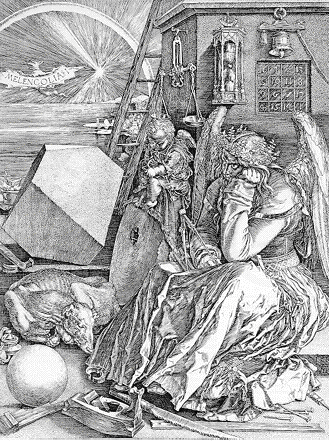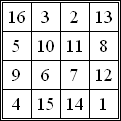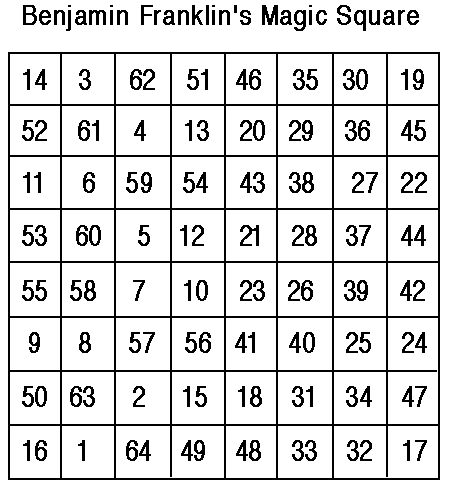

A famous magic square was created by Albert Duerer, a German painter, engraver, and woodcut designer. His magic square was found in his famous painting, Melancholia. This four-by-four magic square is believed to be teh first seen in European art. The magic sum of 34 can not only be seen in its rows, columns, and diagonals, but also on any 2-by-2 block of numbers, the sum of the four corners, the sums of the four outer numbers clockwise from the corners (3 + 8 + 14 + 9) and likewise the four counter-clockwise, and the sum of the middle two entries of the two outer columns and rows (e.g. 5 + 9 + 8 + 12), as well as several kite-shaped quartets, e.g. 3 + 5 + 11 + 15; the two numbers in the middle of the bottom row give the date of the engraving: 1514.


The Passion facade of the Sagrada Familia church in Barcelona, Spain features a four-by-four magic square. The magic sum of the square is 33, the age of Jesus at the time of the Passion. The magic square is similar to the Melancholia, however the number is four of the cells has been reduced by one.
Franklin is best known for his nonscientific pursuits: printer, American revolutionary, ambassador, to mention only a few roles he played. His reputation not onlyrests on his accomplishments as an inventor and as a pioneering theorist in the physics of electricity, but also as a mathematician.
His first published magic square and magic circle was in 1767. Here is a passage from Franklin's autobiography (quoted from Carl van Doren's biography):
"Being one day in the country at the house of our common friend, the late learned Mr. Logan, he showed me a folio French book filled with magic squares, wrote, if I forget not, by one M. Frenicle [Bernard Frenicle de Bessy], in which, he said, the author had discovered great ingenuity and dexterity in the management of numbers; and, though several other foreigners had distinguished themselves in the same way, he did not recollect that any one Englishman had done anything of the kind remarkable. I said it was perhaps a mark of the good sense of our English mathematicians that they would not spend their time in things that were merely 'difficiles nugae', incapable of any useful application."
After discussions with Mr. Logan about how these mathematical curiosities might be helpful, Franklin says, "I then confessed to him that in my younger days, having once some leisure which I still think I might have employed more usefully, I had amused myself in making these kind of magic squares..."
Soon thereafter, Franklin published his eight-by-eight magic square with a magic sum of 260. Any half-row or half-column in this square totals 130, and the four corners plus the middle total 260. In addition, bent diagonals (such as 52-3-5-54-10-57-63-16) also total 260 (Madachy 1979, p. 87).
